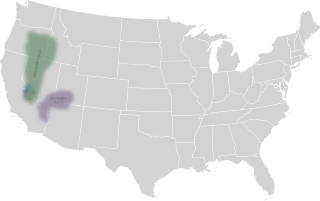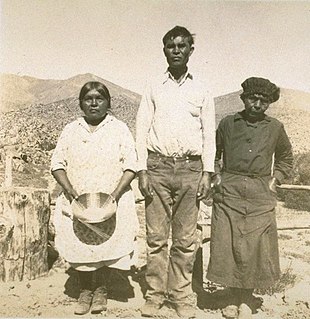
Paiute refers to three non-contiguous groups of indigenous peoples of the Great Basin. Although their languages are related within the Numic group of Uto-Aztecan languages, these three groups do not form a single set. The term "Paiute" does not refer to a single, unique, unified group of Great Basin tribes, but is a historical label comprising:

The Great Basin is the largest area of contiguous endorheic watersheds – those with no outlets – in North America. It spans nearly all of Nevada, much of Utah, and portions of California, Idaho, Oregon, Wyoming, and Baja California, Mexico. It is noted for both its arid climate and the basin and range topography that varies from the North American low point at Badwater Basin in Death Valley to the highest point of the contiguous United States, less than 100 miles (160 km) away at the summit of Mount Whitney. The region spans several physiographic divisions, biomes, ecoregions, and deserts.
The Shoshone or Shoshoni are a Native American tribe with four large cultural/linguistic divisions:

Washo is an endangered Native American language isolate spoken by the Washo on the California–Nevada border in the drainages of the Truckee and Carson Rivers, especially around Lake Tahoe. While there are only 20 elderly native speakers of Washo, since 1994 there has been a small immersion school that has produced a number of moderately fluent younger speakers. The immersion school has since closed its doors and the language program now operates through the Cultural Resource Department for the Washoe Tribe. The language is still very much endangered; however, there has been a renaissance in the language revitalization movement as many of the students who attended the original immersion school have become teachers.
The Indigenous peoples of Arizona are the Native American people of the state of Arizona. These include people that have lived in the region since time immemorial; tribes who entered the region centuries ago, such as the Southern Athabascan peoples; and the Pascua Yaqui who settled in Arizona in the early 20th century.

Uto-Aztecan, Uto-Aztekan or (rarely) Uto-Nahuatl is a family of indigenous languages of the Americas, consisting of over thirty languages. Uto-Aztecan languages are found almost entirely in the Western United States and Mexico. The name of the language family was created to show that it includes both the Ute language of Utah and the Nahuan languages of Mexico.

Numic is a branch of the Uto-Aztecan language family. It includes seven languages spoken by Native American peoples traditionally living in the Great Basin, Colorado River basin, Snake River basin, and southern Great Plains. The word Numic comes from the cognate word in all Numic languages for "person." For example, in the three Central Numic languages and the two Western Numic languages it is. In Kawaiisu it is and in Colorado River, and.

Mono is a Native American language of the Numic group of Uto-Aztecan languages, the ancestral language of the Mono people. Mono consists of two dialects, Eastern and Western. The name "Monachi" is commonly used in reference to Western Mono and "Owens Valley Paiute" in reference to Eastern Mono. In 1925, Alfred Kroeber estimated that Mono had 3,000 to 4,000 speakers. As of 2010 only about 40 elderly people spoke Mono as their first language. It is classified as critically endangered by UNESCO. It is spoken in the southern Sierra Nevada, the Mono Basin, and the Owens Valley of central-eastern California. Mono is most closely related to Northern Paiute; these two are classified as the Western group of the Numic branch of the Uto-Aztecan language family.

The Kawaiisu are a Native Californian ethnic group in the United States who live in the Tehachapi Valley and to the north across the Tehachapi Pass in the southern Sierra Nevada, toward Lake Isabella and Walker Pass. Historically, the Kawaiisu also traveled eastward on food-gathering trips to areas in the northern Mojave Desert, to the north and northeast of the Antelope Valley, Searles Valley, as far east as the Panamint Valley, the Panamint Mountains, and the western edge of Death Valley. Today, some Kawaiisu people are enrolled in the Tule River Indian Tribe.
The Tataviam language was spoken by the Tataviam people of the upper Santa Clara River basin, Santa Susana Mountains, and Sierra Pelona Mountains in southern California. It had become extinct by 1916 and is known only from a few early records, notably a few words recorded by Alfred L. Kroeber and John P. Harrington in the early decades of the 20th century. These word lists were not from native speakers, but from the children of the last speakers who remembered a few words and phrases.
The Tataviam are a Native American group in Southern California. Their tribal government is based in San Fernando, CA, and includes the Executive Branch, Legislative Branch, Tribal Senate, and the Council of Elders. The current Tribal President of the Tatavian people is Rudy Ortega Jr.
The languages of North America reflect not only that continent's indigenous peoples, but the European colonization as well. The most widely spoken languages in North America are English, Spanish, and to a lesser extent French, and especially in the Caribbean, creole languages lexified by them.

The Takic languages are a putative group of Uto-Aztecan languages historically spoken by a number of Indigenous peoples of Southern California. Takic is grouped with the Tubatulabal, Hopi, and Numic languages in the northern branch of the Uto-Aztecan family.
The Paiute-Shoshone Indians of the Lone Pine Community of the Lone Pine Reservation is a federally recognized tribe of Mono and Timbisha Native American Indians near Lone Pine in Inyo County, California. They are related to the Owens Valley Paiute.
Proto-Uto-Aztecan is the hypothetical common ancestor of the Uto-Aztecan languages. Authorities on the history of the language group have usually placed the Proto-Uto-Aztecan homeland in the border region between the United States and Mexico, namely the upland regions of Arizona and New Mexico and the adjacent areas of the Mexican states of Sonora and Chihuahua, roughly corresponding to the Sonoran Desert and the western part of the Chihuahuan Desert. It would have been spoken by Mesolithic foragers in Aridoamerica, about 5,000 years ago.
Arizona, a state in the southwestern region of the United States of America, is known for its high population of Native Americans. Arizona has the third highest number of Native Americans of any state in the Union. Out of the entire US population of 2.9 million Native Americans, roughly 286,680 live in Arizona, representing 10% of the country's total Native American population. Only California and Oklahoma have more Native Americans than Arizona by number. Arizona also has the highest proportion of land allocated to Native American reservations, at 28%. Arizona has five of the twelve largest Indian reservations in the United States, including the largest, the Navajo Nation, and the third-largest, the Tohono O'odham Nation. Also, Arizona has the largest number of Native American language speakers in the United States.
Utah, a state in the western United States that straddles the intersection of the Colorado Plateau, the Great Basin, and the Rocky Mountains, has been the traditional home of several Uto-Aztecan bands from a few tribes that are considered Paiute and Shoshone. The Shoshone in Utah belong to the Goshute and Northern Shoshone linguistic group, while the various Paiute peoples either belong to the Ute or Southern Paiute linguistic classifications. As such, in total, there are two Native American languages spoken in Utah: Shoshone and Colorado River Numic.
Colorado, a state in the western United States that straddles the heights of the Rocky Mountains and the western edges of the Great Plains, has been the traditional home of several Uto-Aztecan, Algonquian, and Tanoan tribes. However, all tribes except for bands of the Ute were relocated to other states, primarily Wyoming and Oklahoma, during the Westward Expansion of the late nineteenth and early twentieth centuries. As such, in total, there is only one remaining Native American language spoken in Colorado: Colorado River Numic.
Wyoming, a state in the western United States that straddles the intersection of the Rocky Mountains and the Great Plains, had been a part of the traditional geographic expanse of various Native American tribes: the Shoshone, the Arapaho, the Cheyenne, and the Crow. During the era of Westward Expansion in the late nineteenth and early twentieth centuries, the Crow were pushed north to Montana, where there was already a significant population of their tribe, and the Cheyenne were split between Montana and Oklahoma. Only the Shoshone and Arapaho remained in Wyoming, with some of both sent to the Wind River Indian Reservation, and others of both pushed to other western states and Oklahoma, respectively. As such, in total, there are two Native American languages currently spoken in Wyoming: Shoshone and Arapaho.
Idaho, a state in the western region of the United States of America, hosts a large number of Native Americans who have traditionally lived in the northern expanses of the Great Basin and the Rocky Mountains. There are five Native American languages that are spoken by recognized tribes of Idaho, two of which fall under the Uto-Aztecan languages classification, while the other three fall under three other language families that are associated with linguistic regions to the west and east of Idaho.







